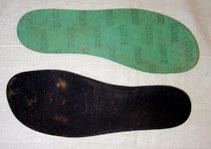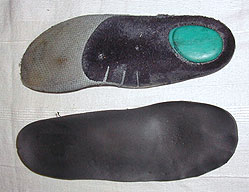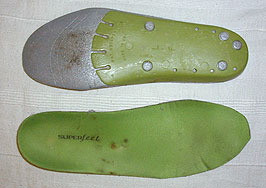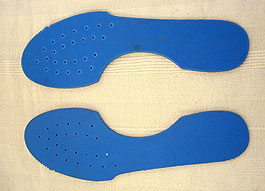Butcher’s
Dog! Regular outdoor fitness tips from the
canine on creatine. Cold wet nose and glossy coat
guaranteed.
This Month – Feet and Pain…
Feet, pain, pain, feet. Twisted ankles, knee pain etc,
etc, etc. What can you do about it?
Whenever you take a step and shift your weight forward so
it comes onto your leading foot, strange bio-mechanical
things happen. For one, the chances are that the weight will
flatten your arch slightly which will elongate and distort
other parts of your foot. The flattening of the foot is
technically called ‘pronation’ and can have major
biomechanical implications – to compensate for the
flattening, the whole leg and hips may shift to compensate
which can cause knee, hip and back pain.
Less seriously the constant flattening of the foot will
fatigue it on long walks, but it can also cause a bunion or
painful swelling behind the joint of the big toe, which
again can lead to long term complications.
Note: an estimated 80 per-cent of us pronate to
some extent. A truly neutral gait is very rare.
Sports Podiatrists – Orthotics

|
Standard insoles – come
with boots but offer minimal
support to the feet. Really they’re just padding.
|
If you have serious motion problems – you may not
realise it, but the chances are that you will be suffering
from painful knees or other joints, the answer is to consult
a qualified sports podiatrist. He or she will examine your
feet and footwear and probably video your walking or running
gait to check your action.
If you do have an imblances that needs correcting, the
podiatrist may well make up a set of orthotics – remedial
footbeds – designed to compensate for your biomechanical
faults and tailored exactly to you. These aren’t cheap –
usually more than £100 – but look at it as an
investment in your longterm health and your activity.
Other Aftermarket Insoles
The original insoles / footbeds that came with your boots
are likely to be pretty basic. Boot makers concentrate on
the main construction of the boot and tend to economise on
the internal trimmings, so what you end up with is an
economic but basic insert that provides minimal support for
the arch and allows the heel to roll around too easily. Not
good.
Shock Absorbing Insoles
We’ve come across and used two different types of
shock-absorbing insoles – Sorbothane and Noene. Both are
made from dense materials that absorb energy, for example,
if you drop a steel ball on a sheet of either, it’ll tend to
stop dead rather than bounce.

|
Noene insoles – thin
with decent shock absorbtion
but flat so no arch support
|
The problem with both, we think, is that they have a
disconcertingly dead feel, particularly if you’re used to
springy EVA-type cushioning as used in most running shoes
and some boots. Some people love them, some don’t, but don’t
make the mistake of thinking that an energy-absorbing insole
will compensate fully for loss of cushioning in running
shoes in particular.
A secondary problem with most of these is that the insert
tends to be flat. As a result if offers little or no support
to either the arch or the heel of the foot. If you insert
them under an existing footbed, they can reduce the internal
volume of the boot substantially, which in turn may cause
new problems.
We’re not saying they’re useless, but be aware of the
drawbacks as well as the pluses. One option with the flatter
versions would be to use them instead of a volume adjuster,
but like we said, the feel is a personal thing.
More Sophisticated Insoles
Over the last year we’ve been using two different
aftermarket insoles regularly for walking and more general
use. The idea is that they’re a halfway house between full
medically produced orthotics and more basic footbeds. Here’s
what we reckon. Bear in mind that the OM paws seem pretty
resilient with no major biomechanical faults.
Conformable Custom Insole

|
Conformably insole is
comfy – note pad under
heel, but more of a super deluxe standard
insole
than one with biomechnical
pluses
|
These are fitted to the feet using a strange vacuum bead
based moulding process. The idea is that the foot is moulded
in an ideal position which the insoles than help to maintain
when walking. The company’s background is in skiing, where
there’s less movement involved than in walking and our
general conclusion is that while the insoles are comfortable
and cushioned, they have limited biomechanical
advantages.
They do conform nicely to the shape of your foot – a bit
like a pair of light running shoe footbeds after a few runs
– but the arch is still quite low. They also take up more
volume than a standard footbed, meaning they can compromise
the fit of your shoes. They’re certainly more comfortable
than a standard version and the fit to your foot means
you’re less likely to slide forward on descents say, but
we’d rate them as more of a super deluxe replacement than a
biomechanical aid.
Superfeet Green Insole
We’ve been using a variety of Superfeet insoles for
around a year now, but the ones we’d actually suggest you
bother with for walking or mountaineering use are the Green
Insoles, so-called because they’re green. At around £30
they’re not cheap, but effectively what you’re getting are a
simple set of orthotics.

|
Our choice – the
Superfeet greens are durable – that green
stuff is a hard plastic – with supportiive arch and
a defined
heel well that cups the heel and ups
stability
|
They won’t compensate for major pronation or other
biomechanical problems, but if you suffer from mild foot
aches and minor leg pain on long walks, they could make a
difference. Compared to the Conformables, these have a
higher arch section with a solid, support underneath
designed to prevent your foot from collapsing on
landing.
The other main feature is a very defined heel cup
designed to support the back of the foot firmly and minimise
heel roll on landing. The high arch feels odd at first, but
you soon get used to it and we now use the Superfeet
routinely for both walking and running. They’ve proven to be
very tough and the hard plastic foundation used means that
the performance hasn’t deteriorated so far. Nice.
We’ve noticed a general reduction in foot fatigue, but
more impressively, friends with more significant
biomechanical problems say they’ve experienced a huge
difference. Another benefit for some is that preventing the
elongation of the foot under pressure actually means they
can wear smaller boots.
Disadvantages? Slightly higher volume than standard
insoles plus if you’re one of the rare minority who don’t
pronate then they may not be suitable for you. Superfeet
retailers should be able to advise. Finally, if you do have
major problems, they’re not a substitute for properly
designed orthotics, though Superfeet do offer a custom-made
option at a limited number of outlets. See the web
site for more details.
Volume Adjusters

|
KSB Volume Adjusters –
no biomechanical advantage
but can make a big difference to fit by reducing
the internal
volume of the boot.
|
Not to be confused with insoles, volume adjusters are
intended to change the internal volume of a boot and are
flat, dense, non-compressible foam worn under a footbed.
They can improve the foot of a boot for those with low
volume feet and may help avoid heel blisters by stopping
foot movement generally and moving the heel upwards to a
more tapered section of the boot.
Other Foot Hints
Ankles if you have weak ankles, the key to
stability is a good, supportive heel section. High ankles
will feel supportive and, in extreme situations might even
be able to prevent your ankle from turning physically, but
real stability comes from lower down.
Socks Thick socks may impove fit and comfort
initially, but as they pack down, they’ll actually allow
your feet to move around too much and can cause instability.
Better to wear thinner socks with cushioning in the right
places.
Fit If you do use orthotics or insoles, take them
along when you buy boots and always try footwear in the
afternoon when your feet have swollen slightly.
| 






